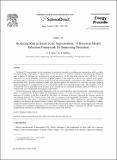Reducing risk in basin scale sequestration: A Bayesian model selection framework for improving detection
Author(s)
Seto, C.J.; McRae, Gregory J.
DownloadSeto-2011-Reducing risk in bas.pdf (257.4Kb)
PUBLISHER_CC
Publisher with Creative Commons License
Creative Commons Attribution
Terms of use
Metadata
Show full item recordAbstract
Geological CO[subscript 2] sequestration is a key technology for mitigating atmospheric greenhouse gas concentrations while providing low carbon energy. Deployment of sequestration at scales necessary for a material contribution to greenhouse gas mitigation poses a number of challenges not encountered in current operations. At the basin scale, injection sites will not be as well characterized as current operations. Predictions of system response to this magnitude of injection are expected to have greater uncertainty and risk. Through an integrated, model based design and assimilation, monitoring provides a platform for mitigating the associated risks. Because footprints of basin scale injection projects are expected to be very large, the high resolution monitoring programs in existing projects are not economically feasible for monitoring at large scales. The acceptable levels of resolution and risk are dependent on the footprint of the network and the monitoring technique employed, which are in turn, constrained by cost of deployment and regulatory requirements.
Network design must make an implicit assumption on the size of the leak that is able to be measured. Leak detection at the surface is complicated by the many natural and anthropogenic sources of CO[subscript 2] that can mask a leak or result in the incorrect assessment of whether a leak has occurred. In this paper, we introduce a Bayesian framework for decision support in discriminating between CO[subscript 2] detected from a leak and CO[subscript 2] measured from background fluctuations. For small leakage concentrations, the signal cannot be distinguished from background fluctuations. When complementary observations are jointly considered, the ability to discriminate between a leakage and background concentrations improves, and the number of samples required for confident detection decreases. Incorporation of Bayesian decision support tools into monitoring programs will assist in reducing risk in geological sequestration in a cost effective manner by providing a framework for efficient integration of complementary observations and enhancing the information content of the network.
Date issued
2011-04Department
Massachusetts Institute of Technology. Department of Chemical EngineeringJournal
Energy Procedia
Publisher
Elsevier
Citation
Seto, C.J., and G.J. McRae. “Reducing Risk in Basin Scale Sequestration: A Bayesian Model Selection Framework for Improving Detection.” Energy Procedia 4 (2011): 4199–4206.
Version: Final published version
ISSN
18766102